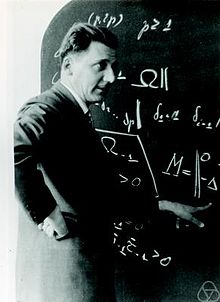Fabio Conforto
Fabio Conforto (born August 13, 1909 in Trieste , † February 24, 1954 in Rome ) was an Italian mathematician who mainly dealt with algebraic geometry .
Life
Conforto was born in Trieste, then part of Austria-Hungary, but had Italian-speaking parents. He grew up partly in Vienna and spoke German like a native speaker. In 1918 he returned with his parents to Trieste, which was now under Italian administration and came to Italy in 1920. He studied mathematics at the Polytechnic in Milan (with Oscar Chisini ) and from 1928 at the University of Rome , where he studied with Vito Volterra , Guido Castelnuovo , Federigo Enriques and Tullio Levi-Civita . He received his laureate in 1931 at the University of Rome and then went to the University of Göttingen in 1931/32 , where he heard from Hermann Weyl and Gustav Herglotz and learned modern algebra from Emmy Noether's school . He then did his military service before returning to the University of Rome, where he was heavily influenced by the school of algebraic geometry of Castelnuovo, Enriques and Francesco Severi . He was assistant to Castelnuovo and, after his retirement in 1935, to Enrico Bompiani . In 1939 his first book, Le Superficie razionali (The rational surfaces) appeared on the basis of lectures by Enriques. He also worked at the National Institute for Applications of Analysis by Mauro Picone . In 1939 he won the chair for analytical and descriptive geometry in Rome, which had become vacant that same year after the death of Gaetano Scorza . He was briefly called up at the beginning of the Second World War, but otherwise worked again at the Picone Institute on war-related research, which is why he visited Germany with Picone in 1943. He volunteered for the Allied invasion of Italy in 1943 to fight the Americans and was captured in Reggio Calabria. Released after the capitulation of Italy, he taught at the Military Academy in Lecce and returned to Rome in August 1944.
In 1950 he attended the International Congress of Mathematicians in Cambridge and worked in Princeton with Carl Ludwig Siegel . In 1951/52 he traveled extensively in Austria, Germany, Switzerland and the Netherlands and became a member of the Mainz Academy of Sciences. In 1953 he fell seriously ill with pleurisy and died of the consequences.
During his lifetime he wrote several textbooks (e.g. on analytical and descriptive geometry and mechanics and algebra for high schools). Posthumously after his lectures Abelian Functions and Algebraic Geometry (Springer Verlag, Grundlehren der Mathematischen Wissenschaften 1956) and Introduzione alla topologica (1960) appeared.
He was also musically interested and studied piano and violin at the conservatory during his student days. In 1936 he married Antonietta Pellegrini, with whom he had four children.
Web links
- John J. O'Connor, Edmund F. Robertson : Fabio Conforto. In: MacTutor History of Mathematics archive .
| personal data | |
|---|---|
| SURNAME | Conforto, Fabio |
| BRIEF DESCRIPTION | Italian mathematician |
| DATE OF BIRTH | August 13, 1909 |
| PLACE OF BIRTH | Trieste |
| DATE OF DEATH | February 24, 1954 |
| Place of death | Rome |
